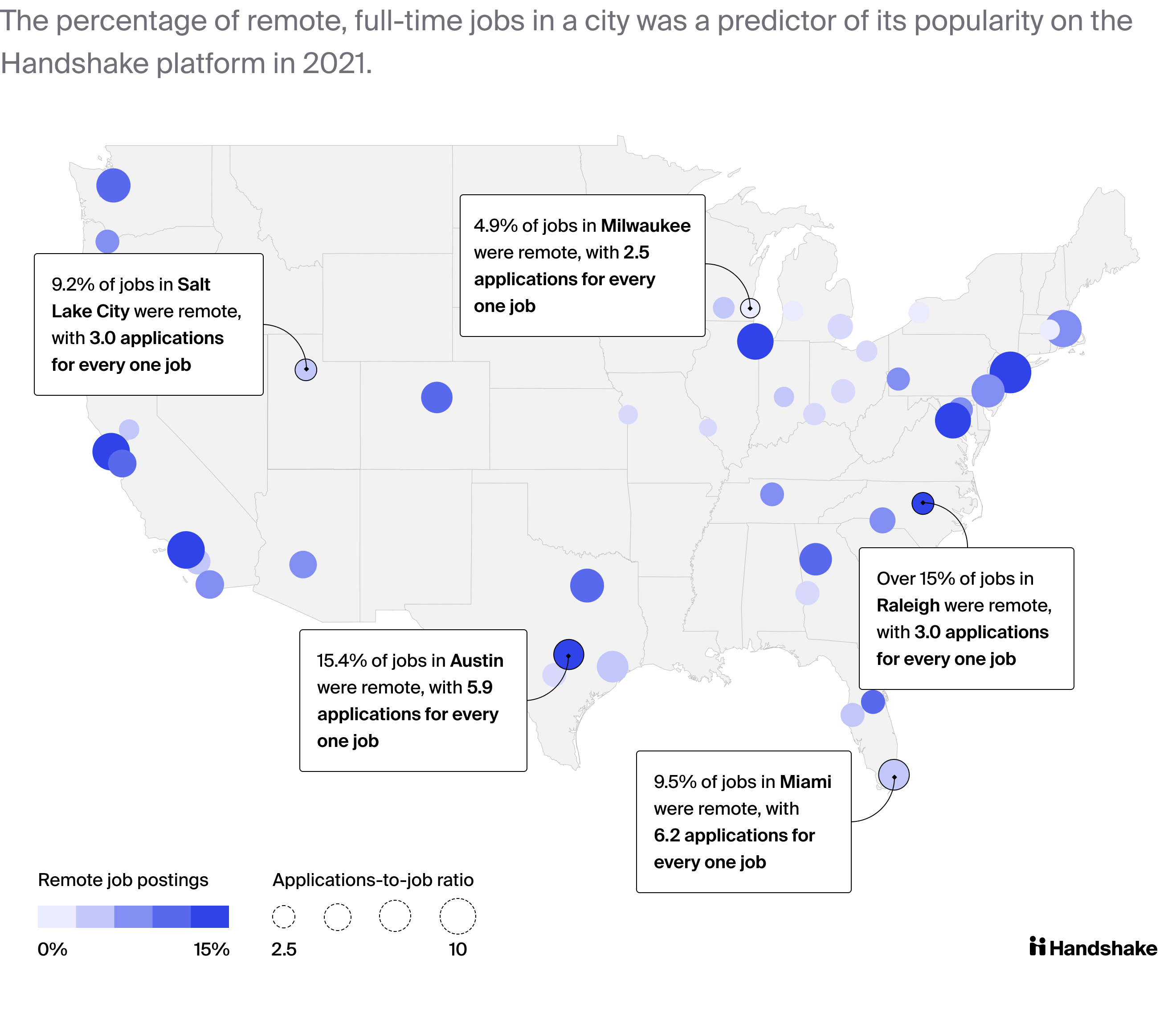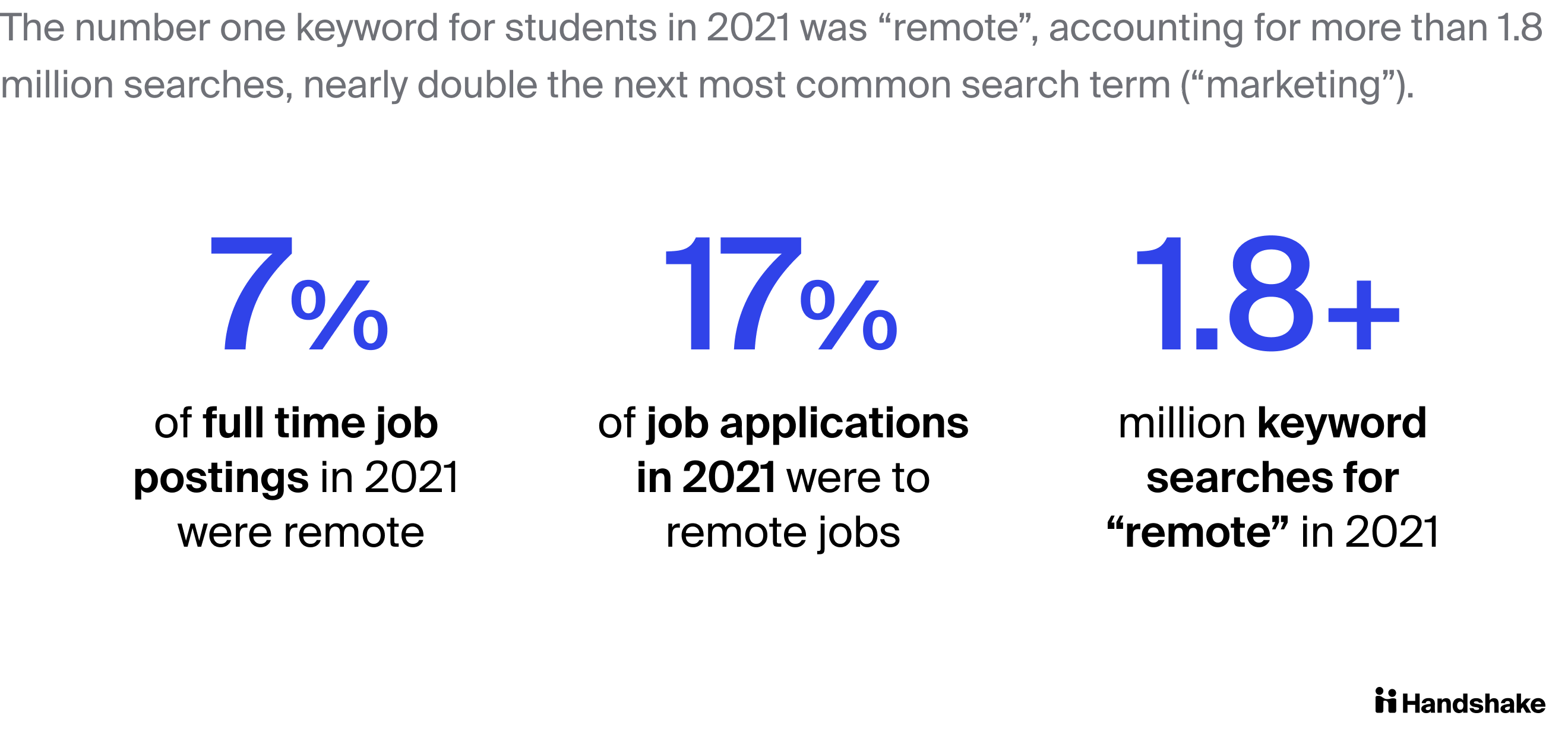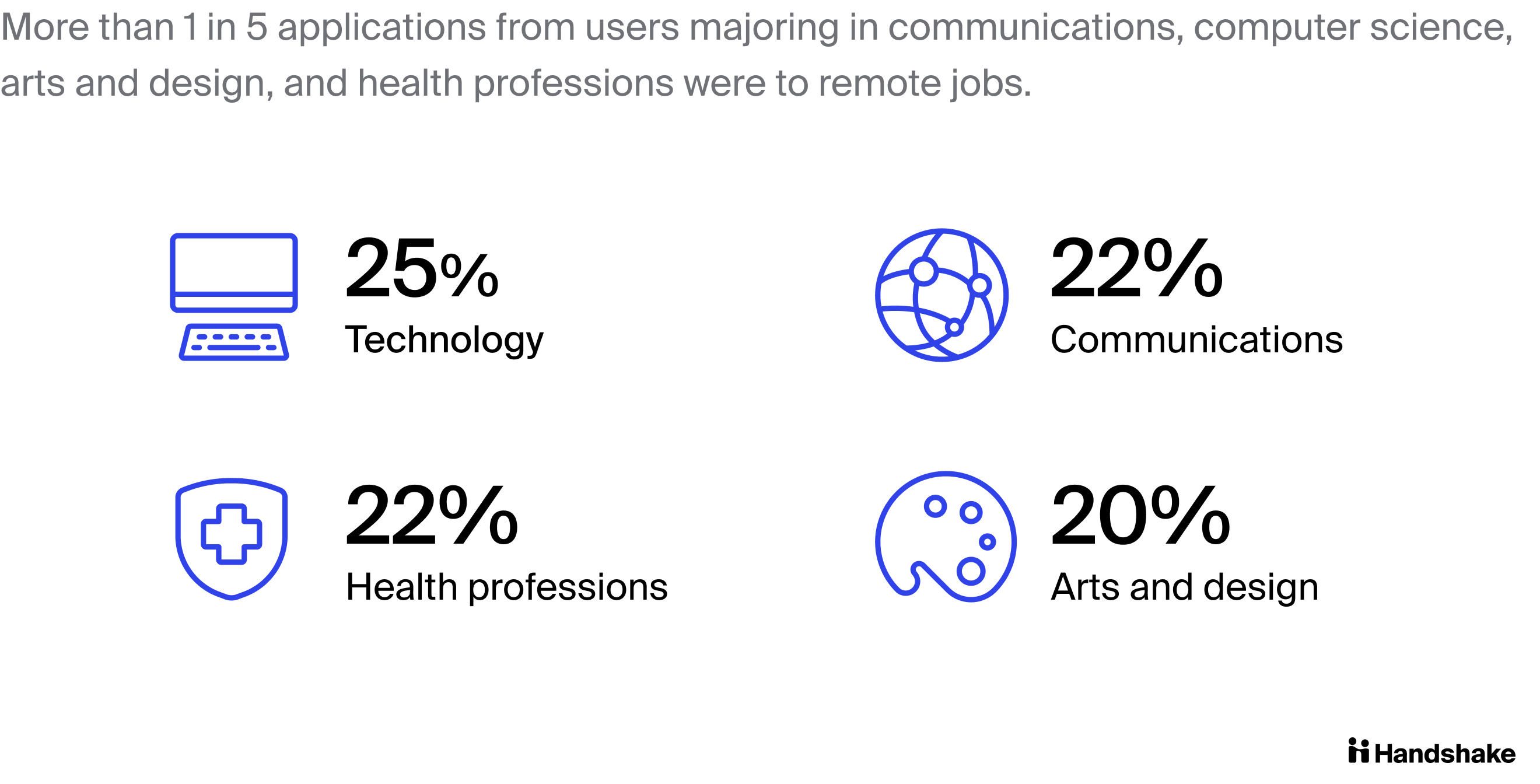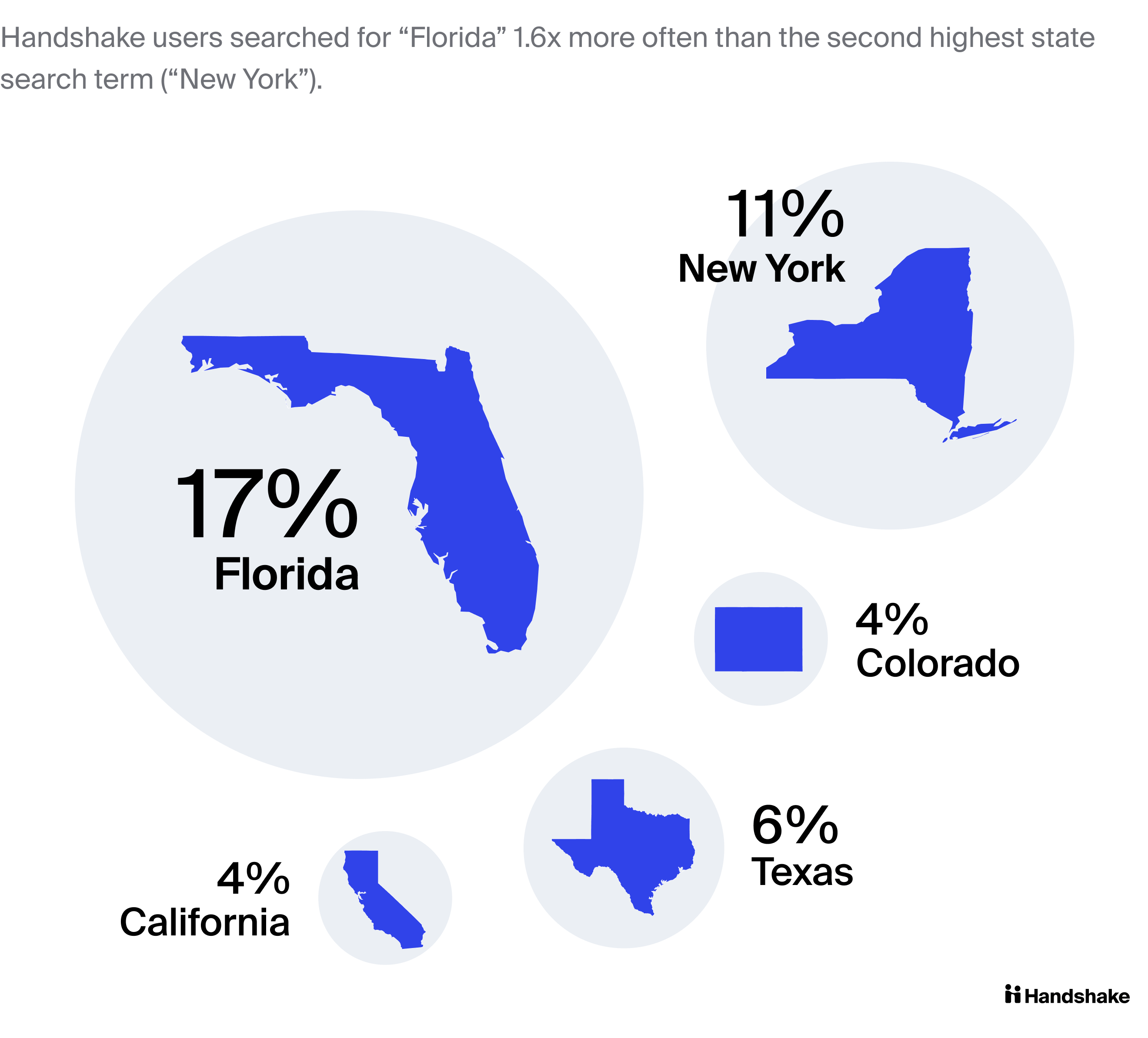
The changing map of Gen Z jobseekers
Beyond remote, flexibility is top of mind for Gen Z
After multiple waves of COVID-19 and the continued delay of return-to-office plans, employers, workers, and the media are still asking, “How long will remote work stick around?” But the dichotomy between “still remote, for now” and “back to the cubicle” is a false one. Flexible work is no longer a temporary compromise—it’s a new reality. In this report, insights drawn from Handshake’s platform show that while remote jobs get nearly triple the applications that non-remote jobs do, Gen Z applicants still care about location and cost of living. These interplaying preferences are reshaping work in real time.
Key takeaways
- Gen Z wants remote work: in 2021, remote jobs were almost 3x more popular than non-remote jobs among Handshake users.
- Cities with the most remote jobs are more popular: the proportion of remote full-time jobs in a city was a statistically significant predictor of its popularity in 2021, with every 5% increase in remote jobs translating to an increase of one application per job.
- But Gen Z is not indifferent to geography: multiple factors play into their career decisions, including a desire for flexibility and a reasonable cost of living.
- Not just tech majors: 22% of all applications from communications majors, 20% from art and design majors, and 22% from health professions majors were to remote roles (compared to 25% from computer science and information systems majors).
- Two case studies: Miami and Washington D.C. highlight how differences in affordability, remote work opportunities, and industry hubs play into applicants’ job decisions.
The United States of remote work

The continued rise of remote
Although remote jobs made up only 7% of full time job postings on Handshake in 2021, these roles received an outsized interest from Gen Z, accounting for 17% of all total job applications on the platform.
Remote jobs got nearly 3x as many applications

This analysis used two data points (whether a role is remote, and location the role is based in) provided by employers in job postings to track the difference in total remote jobs across cities. As an example, a remote role based in Atlanta would be open to local candidates as well as remote-friendly to candidates based elsewhere.
When compared with the popularity of a city (the number of applications divided by the overall number of jobs), there was a strong correlation between a city’s proportion of remote jobs and its desirability. Many employers have retained their offices, where employees may be working part time; others have committed to a fully distributed workforce. But no matter how “remote” is defined, it gets outsize attention from applicants.
Cities with the highest proportion of remote jobs are seeing the most interest from job seekers

It’s not surprising that a place like San Francisco, a hub of tech recruiting, is getting attention from applicants because of its outsize number of remote tech roles. And it’s true that tech jobs are frequently listed as remote: more than 1 out of 4 jobs in tech and IT were marked as “remote” on the Handshake network.
But, this trend goes beyond industries. The percentage of remote jobs in a city remained a statistically significant predictor of its popularity on the platform in 2021, with every 5% increase in remote jobs translating to an increase of one application per job. This remained true even when controlling for a city’s population and tech sector.
Interest in remote work is not limited by an applicant’s major

Beyond remote, Gen Z is looking for flexibility
In addition to looking at application data, Handshake surveyed over 1,800 users to better understand their preferences. Their answers hinted at a wide desire for hybrid work. Many mentioned that they crave at least some in-person interaction and opportunities to network, especially in their first roles out of college.
But despite expressing reservations about working remotely 100% of the time, survey respondents consistently mentioned the myriad benefits that remote work offers: greater control (setting their own schedule; less micromanagement), better focus, and improved quality of life (skipping a long commute, taking breaks to exercise, having flexibility to care for a child or older family member).
It may be that jobs marked “remote” send the signal that the employer is open to flexible work arrangements. Employers committed to hiring Gen Z talent should carefully consider which jobs truly need to be in the office, and which can be done remotely. Showing flexibility is an important indicator that a company can respond to their employees’ needs beyond salary.
In the words of Anisah, a recent graduate of the University of Washington: “This generation of college graduates is overqualified, efficient, creative, effortlessly tech savvy, and increasingly unwilling to settle for a job that does not give us what we deserve or respects our personal needs. Employers need to know that we prioritize a work-life balance, healthy company culture, and fair compensation for our labor so that we can afford to live comfortably. We can’t afford to settle for less.”
Remote work reshapes the map: two case studies
The wide availability of remote jobs is transforming cities and creating new hubs of Gen Z talent. Gen Z is not just optimizing for the best job—they are looking for work-life benefits that come from more affordable living, too. A student at the University of Dayton commented, “I think that the most up-and-coming cities are going to be smaller cities like Dayton because Gen Z people don’t aspire to work in offices as much as past generations. The appeal of cities and apartment living has gone down while housing prices in big cities have skyrocketed.”
Two cities—Miami and Washington D.C.—demonstrate how cost of living, remote work opportunities, and industry hubs play into applicants’ decisions.
Miami
Miami had 2.3x more applications per job than anticipated for a city of its size and demographics. Miami’s cost of living is nearly 40% lower than Brooklyn; meanwhile, it is emerging as a new finance and tech hub.1 Financial firms, such as Blackstone and Goldman Sachs, have opened offices in Miami, giving applicants an alternative to building their careers on Wall Street while staying in the same time zone. Fintech and crypto companies—like London’s Blockchain.com, which chose Miami as its US headquarters in 2021—have also gravitated to the city.
In Miami, the combination of affordability and remote opportunity, as well as new booming industries, contributed to a noticeable interest from Gen Z: Florida was the most searched location on the Handshake network in 2021.
Top 5 most searched states in 2021

Washington, D.C.
D.C. had one of the highest rates of remote jobs on the Handshake Network: compared to Miami, it had almost five percentage points more remote jobs in 2021 (14.4% in D.C., versus 9.5% in Miami).
The remote job gap between Miami and D.C. underscores the ways local labor markets have been transformed over the past two years: during the pandemic lockdowns, more than half of D.C’s workforce was able to work from home—60% of adults reported working remotely, versus just 30% in Florida and 36% in Texas.2
On Handshake, the shift to remote work was seen across all of D.C.’s industries. For example, 16% of non-profit jobs in D.C. were remote (10 percentage points higher than the proportion of remote jobs posted to the Handshake network.) And 9% of government jobs—D.C.’s largest sector—were remote, 5 percentage points higher than the Handshake network.
These changes go beyond just jobs, transforming cities as Gen Z workers assess affordability, flexibility, and quality of life: census data showed that D.C.’s population shrank in 2021 by around 20,000 residents, or 2.9 percent.3 The wide availability of remote jobs may be allowing workers to remain in (and get hired for) roles, while giving them flexibility to live in regions with lower costs of living in the wider D.C. metro area (in 2021, D.C. had the second-highest cost of living index in the U.S., after Hawaii).4
Conclusion
“I realize that almost anything that is done in person can be done online. I focus much more in the comfort of my home and feel as if I can go at my own pace. Doing a job online allows me to have a balance between work and life. It allows me to feel comfortable and do my job to the best of my ability.” —Alexis, Fordham University
The expectations of work have changed. During the pandemic, flexible schedules, work-life balance, and employer sensitivity to individual needs—dimensions of work that Gen Z already valued – became paramount for workers. Gen Z’s continued interest in remote and hybrid work will have real economic impact, and employers will have to carefully assess their degree of flexibility in order to attract early talent.
Methodology
Remote work: In order to understand remote trends, we utilized two key data points submitted by employers when creating a full-time job posting on Handshake: whether the job is remote or remote-friendly (a “remote” flag), and the city where the job was based.
We grounded our analysis in an employer’s remote flag, a clear signal from employers about whether the poster explicitly considered a job open to remote work. This means that jobs that just contained the words “remote” or “telework,” or phrases like “work from home,” were not considered remote jobs in this analysis.
Remote job modeling: To understand the relationship between remote jobs and a city’s “popularity” in terms of applications (i.e., the number of applications divided by the overall number of jobs), we created a multiple linear regression model, controlling for factors such as the number of jobs in a city’s technology sector, the total number of applications created in 2021, and the city’s population using recent U.S. census numbers.
Endnotes
Learn more
-
-
A drop in tech hiring? Employer demand for TikTok skills? Check out short, bite-sized insights from our network at the Handshake Network Trends blog.
Check out the blog -
Dive deeper into remote working trends and learn which cities are benefiting most from Gen Z’s interest in distributed work.
Read the report